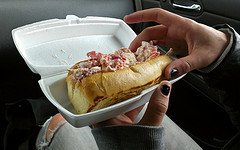Here’s Why You’re Probably Paying Way Too Much For A Lobster Roll
According to The Atlantic, you can get a fresh lobster off the boat in Maine for around $2.20/pound. Your average lobster roll contains about the same amount of meat as you’d find in a 1-pound lobster. But it’s hard to find a lobster sandwich for under $15, with some eateries charging upwards of $30 for a lobster roll. If a burger or chicken sandwich was going for that sort of price, it had better be wrapped in gold-leafed bacon.
There are basically three reasons why people still pay high prices even when lobster is cheap as chicken.
1. Perception
Lobster is supposed to be expensive, or at least that’s what we’ve been taught over the years. It’s one of those cliches of the newly wealthy — ordering filet mignon and lobster with a bottle of champagne. So not only have we come to accept as a culture that lobster should cost more, we’ve grown to be wary of anyone selling it for less than we expect.
If someone offers you a Rolex for $10, you’d probably assume it was fake or broken, so a lobster roll that costs the same as a diner burger would likely arouse suspicion. I remember my first time driving through Maine and seeing lobster rolls at McDonald’s. My travel companion and I — both stupid college kids at the time — scoffed at the notion and turned our nose up at them while we had no problem paying triple the price elsewhere. As I said, we were stupid.
2. Availability
Even in New York City, it’s not easy to find a place that serves lobster rolls. The Atlantic pulls together prices from 6 area restaurants, but there are several thousand eateries in the city that don’t offer the sandwich. So even in places where you can get every kind of food you’d want, you’re still hard-pressed to find a quality lobster roll.
Thus, even though the restaurants may be getting the lobsters for low, low prices, diners’ options are few and far between. In such a case, the restaurants can test the limits of the market to see what it will bear.
3. Hedging
Lobster prices aren’t always low, and they fluctuate all the time. This is why many restaurants simply list “Market Price” next to the cost on the menu (in addition to the fact that those sorts of notations make the customer feel like he or she is ordering some sort of especially cool and exclusive item, when it’s just a lobster). In order to guard against fluctuations, it makes sense for restaurants to just charge the most that people are willing to pay. That way, the eatery is still covered when the price doubles. They won’t have to increase the menu price and risk losing customers who were on the lobster bubble.
Want more consumer news? Visit our parent organization, Consumer Reports, for the latest on scams, recalls, and other consumer issues.


